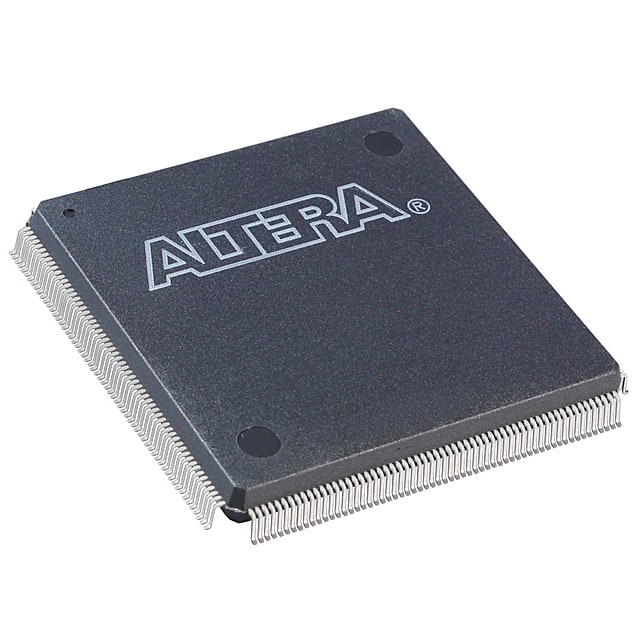EPF10K100EQC240-3N
Product Overview
Category
The EPF10K100EQC240-3N belongs to the category of programmable logic devices (PLDs).
Use
This product is primarily used in digital circuit design and implementation. It provides a flexible and customizable solution for various applications.
Characteristics
- Programmable: The EPF10K100EQC240-3N can be programmed to perform specific functions based on user requirements.
- High Capacity: With 100,000 usable gates, this PLD offers ample resources for complex designs.
- Low Power Consumption: The device is designed to operate efficiently, minimizing power consumption.
- Versatile I/O Options: It supports a wide range of input/output configurations, enabling connectivity with different components.
- Fast Operation: The EPF10K100EQC240-3N operates at high clock speeds, ensuring rapid data processing.
Package
The EPF10K100EQC240-3N is available in a compact quad flat pack (QFP) package. This package type ensures easy integration into circuit boards.
Essence
The essence of the EPF10K100EQC240-3N lies in its ability to provide reconfigurable logic functions, allowing designers to create custom digital circuits without the need for dedicated hardware.
Packaging/Quantity
This product is typically packaged in reels or trays, depending on the manufacturer's specifications. The quantity per package may vary, but it is commonly available in quantities of 100 or more.
Specifications
- Device Type: Programmable Logic Device (PLD)
- Family: EPF10K
- Model: 100EQC240-3N
- Logic Cells: 100,000
- I/O Pins: 240
- Operating Voltage: 3.3V
- Maximum Clock Frequency: 200 MHz
- Package Type: Quad Flat Pack (QFP)
- Temperature Range: -40°C to 85°C
Detailed Pin Configuration
The EPF10K100EQC240-3N has a total of 240 I/O pins, which are configurable based on the desired circuit design. The pin configuration varies depending on the specific application and user requirements. Please refer to the manufacturer's datasheet for detailed pin assignments.
Functional Features
- Reconfigurable Logic: The EPF10K100EQC240-3N allows users to modify the logic functions of the device, providing flexibility in circuit design.
- Embedded Memory: This PLD includes embedded memory blocks that can be utilized for data storage or lookup tables.
- Clock Management: The device offers various clock management features, including phase-locked loops (PLLs) and delay-locked loops (DLLs), enabling precise timing control.
- Built-in I/O Interfaces: The EPF10K100EQC240-3N supports different I/O standards such as LVCMOS, LVTTL, and LVDS, facilitating compatibility with various external components.
Advantages and Disadvantages
Advantages
- Flexibility: The reprogrammable nature of the EPF10K100EQC240-3N allows for quick iterations and modifications during the design process.
- Cost-Effective: By eliminating the need for dedicated hardware, this PLD reduces overall development costs.
- High Integration: With a large number of logic cells and I/O pins, it can accommodate complex designs in a single device.
- Fast Prototyping: The ability to rapidly implement and test different logic functions accelerates the prototyping phase.
Disadvantages
- Learning Curve: Utilizing programmable logic devices requires familiarity with hardware description languages and design tools.
- Limited Performance: While suitable for many applications, the EPF10K100EQC240-3N may not offer the same performance as dedicated ASICs or FPGAs.
- Power Consumption: Although designed to be power-efficient, PLDs can consume more power compared to application-specific solutions.
Working Principles
The EPF10K100EQC240-3N operates based on the principles of field-programmable gate arrays (FPGAs). It consists of an array of configurable logic blocks (CLBs) interconnected through programmable interconnects. These CLBs contain look-up tables (LUTs), flip-flops, and other components that can be configured to implement desired logic functions. The device is programmed using hardware description languages (HDLs) such as VHDL or Verilog, which define the desired circuit behavior.
Detailed Application Field Plans
The EPF10K100EQC240-3N finds applications in various fields, including:
- Communications: Used in networking equipment, routers, and switches for custom protocol handling and data processing.
- Industrial Automation: Employed in control systems, PLCs, and robotics for implementing complex logic functions.
- Automotive Electronics: Util
기술 솔루션에 EPF10K100EQC240-3N 적용과 관련된 10가지 일반적인 질문과 답변을 나열하세요.
Sure! Here are 10 common questions and answers related to the application of EPF10K100EQC240-3N in technical solutions:
Question: What is EPF10K100EQC240-3N?
- Answer: EPF10K100EQC240-3N is a field-programmable gate array (FPGA) manufactured by Intel (formerly Altera). It is designed for high-performance applications and offers 100,000 logic elements.Question: What are the key features of EPF10K100EQC240-3N?
- Answer: Some key features of EPF10K100EQC240-3N include 240-pin package, 3.3V power supply, 100,000 usable gates, and 240 user I/O pins.Question: What are the typical applications of EPF10K100EQC240-3N?
- Answer: EPF10K100EQC240-3N can be used in various applications such as telecommunications, industrial automation, medical equipment, aerospace, and defense systems.Question: How can EPF10K100EQC240-3N be programmed?
- Answer: EPF10K100EQC240-3N can be programmed using hardware description languages (HDLs) like VHDL or Verilog, which describe the desired functionality of the FPGA.Question: Can EPF10K100EQC240-3N be reprogrammed?
- Answer: Yes, EPF10K100EQC240-3N is a field-programmable device, meaning it can be reprogrammed multiple times to implement different functionalities.Question: What tools are available for programming EPF10K100EQC240-3N?
- Answer: Intel provides Quartus Prime software, which is a comprehensive development environment for designing, simulating, and programming EPF10K100EQC240-3N.Question: What are the advantages of using EPF10K100EQC240-3N in technical solutions?
- Answer: EPF10K100EQC240-3N offers high flexibility, allowing designers to implement custom logic functions. It also provides high performance, low power consumption, and fast time-to-market.Question: Can EPF10K100EQC240-3N interface with other components or devices?
- Answer: Yes, EPF10K100EQC240-3N has multiple I/O pins that can be used to interface with other components or devices such as sensors, actuators, memory modules, or communication interfaces.Question: Are there any limitations or considerations when using EPF10K100EQC240-3N?
- Answer: Some considerations include power supply requirements, thermal management, and ensuring proper signal integrity in high-speed designs. The datasheet and application notes provided by Intel should be consulted for detailed guidelines.Question: Where can I find more information about EPF10K100EQC240-3N?
- Answer: You can find more information about EPF10K100EQC240-3N on Intel's website, including datasheets, application notes, and user guides specific to this FPGA model.
Please note that the answers provided here are general and may vary depending on the specific requirements and context of your technical solution.


